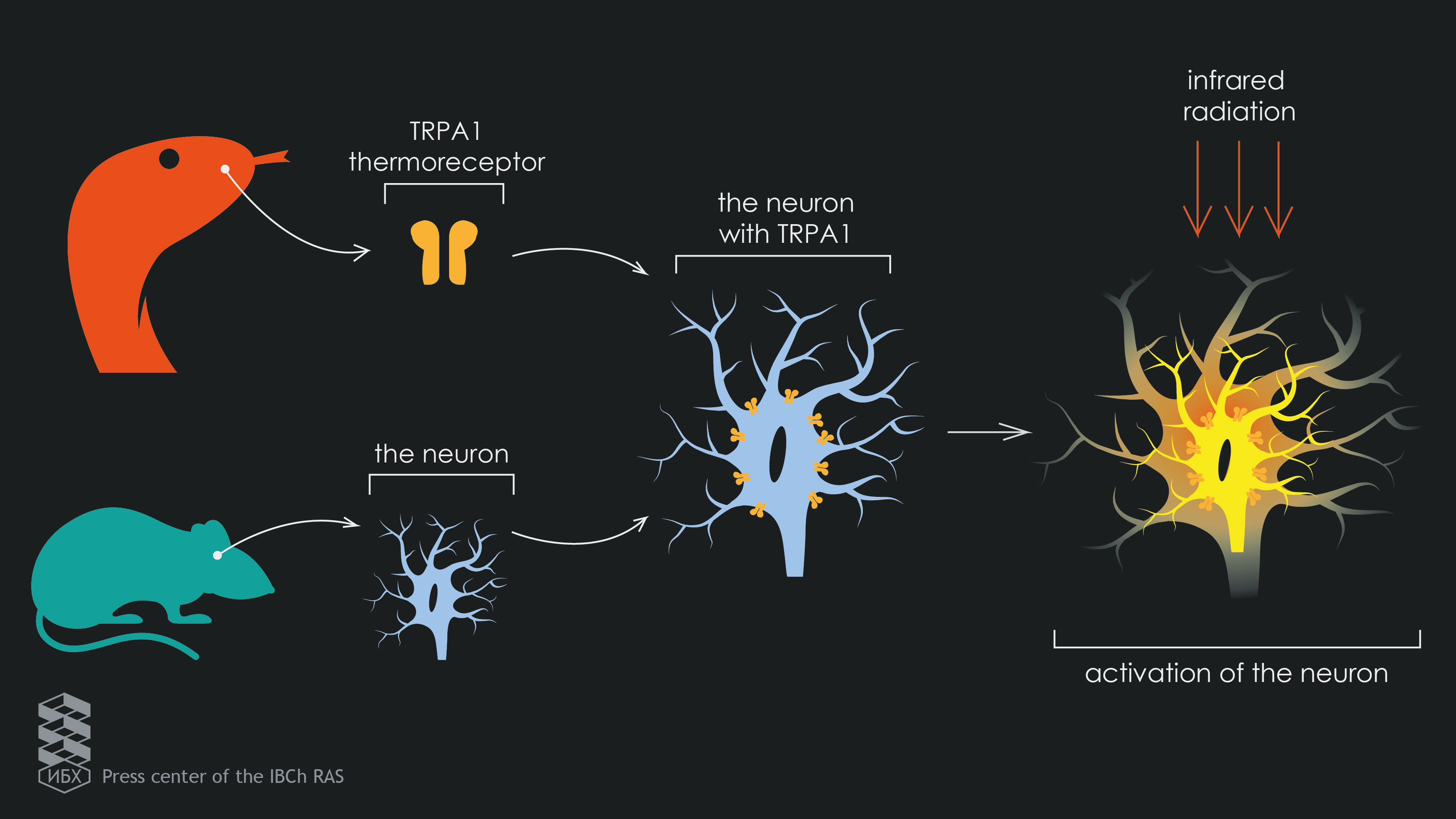Press-room / news / Science news /
Russian scientists study to control a neural network through infrared radiation
Researcher from the Institute of Bioorganic Chemistry of the Russian Academy of Sciences together with their colleagues have developed a method for stimulating neurons with infrared radiation. They implemented in mice neurons snake proteins that react to temperature – thermoreceptors. Published in Nature Communications journal results will help non-invasive stimulate neural networks in the deep layers of tissues in the body, as well as control the activity of other types of cells in living systems. In the future, it can help in the therapy of various nervous system diseases.
“Scientists for a long time have been interested in the question of how to selectively control neurons,” tell Yuliya Ermakova, a researcher of the Laboratory of Molecular Technologies, IBCh RAS, the first author. “In 1979, Francis Crick, one of the pioneers of the DNA structure, suggested that the main challenge in neuroscience is the creation of methods that would stimulate a certain type of neurons, while other cells would remain insensitive to stimulus. Electrodes and drugs could did not deal with it because of their rough and inaccurate characteristics. Crick believed that light would be suitable for these purposes. To realize the scientist’s idea was possible only in 2005, when a group of researchers from Stanford University under the leadership of Karl Disserota could excite neurons through light irradiation. This method was called optogenetics, a combination of optics and genetics.”
Neurons acquire sensitivity to light due to artificially placed receptor proteins in them, in nature they help living organisms orient themselves in the environment. Depending on the types of physical impact, the receptors are divided into different classes. Thus, light signals are perceived by rhodopsins and phototropins, and temperature fluctuations are perceived by the thermoreceptors of the TRP family (Transient receptor potential). It helps us feel hot or cold objects, as well as a taste of spicy food or menthol cold. Thermoreceptors formed the basis of the thermogenetics method, which also makes it possible to selectively influence on the neurons by longwave infrared radiation, much deeper than the visible light penetrating the tissues.
In their study, scientists from the Shemyakin-Ovchinnikov Institute of Bioorganic Chemistry of the Russian Academy of Sciences (RAS), the Institute of Higher Nervous Activity and Neurophysiology RAS and the Lomonosov Moscow State University used TRPA1 snake thermoreceptors as receptor-proteins, which are responsible for thermal vision – the ability of some snakes to "see" some warm objects at a distance. It helps animals to navigate in space and hunt in the dark.

Автор: Снежана Мажекенова.
The first part of the experiments was carried out on the culture of mice neuron cells. From the fiber optic laser installation, neurons were fed by infrared light. Their activation was recorded by measuring the flow of ions passing through the cell membrane – the main participants in the signal transmission in the cell.
“So we established that the activation of thermally sensitive channels TRPA1 occurs within the first milliseconds after the laser pulse is applied,” explains Yuliya. “It makes possible to use thermogenetics to rapidly stimulate neurons and to reproduce complex combinations of different pulses at a rate of up to 50 pulses per second.”
To confirm that thermogenetics can be used to stimulate behavioral responses in a living organism (in vivo), the researchers conducted an experiment on Danio rerio fish, which were divided into two groups. The fish from the experimental group had snake thermoreceptors TRPA1 implemented into the cell membrane in certain neurons, and fish from the control group had only the fluorescent (“luminous”) label. After that, the researchers increased the body temperature of the fish at a certain point with a beam of infrared light (60 micrometers in diameter, which is slightly larger than the size of a large neuron). In response, the experimental fish experienced a false sense of touch and tried to swim away, making the reflex tail sweep, while the second group of fish was completely insensitive to the effects of the laser.
The study included not only the biological, but also the physical component. To conduct thermogenetic stimulation, it is extremely important to heat live tissue at a prescribed temperature not exceeding 1-2 degrees. Insufficient heating is not able to activate neurons. Excessive heat will lead to neurons overheating and death. Therefore, a team from Moscow State University, led by Aleksey Zheltikov, developed a method for local temperature detection using quantum effects in microparticles of diamonds that had special crystal lattice defects. Such diamond, placed on the tip of the optical fiber, is able to measure the temperature of the heated sample with high accuracy.
“The method of thermogenetics opens wide prospects for its use in science and for further development,” says Vsevolod Belousov, head of research, head of the Laboratory of Molecular Technologies, IBCh RAS. “Firstly, the infrared radiation penetrates deeper into the tissue, which means that it will be possible to stimulate deeper layers of the brain. Moreover, not only infrared radiation, but also focused microwave waves or high-power magnets can be used for heating. Secondly, thermogenetics has a huge advantage in working with small model animals, such as fish fry or fruit flies. In classical optogenetic experiments, they see the blue light used to activate neurons, and are frightened of it. IR radiation for them is invisible, so you calm of adverse reactions of the animal to bright light. Thirdly, the obtained molecular and technical tools can be used to activate not only neurons, but also other cells. All this together will lead to the emergence of new approaches to therapeutic stimulation or, conversely, the suppression of the functions of various cells in the body.”
Optogenetics is making the first steps in this area, and now thermogenetics, brought out by this work to a new level, will join it.
may 26, 2017

